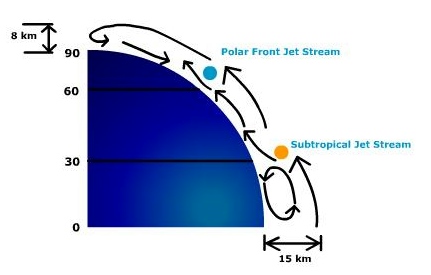Wind and Pressure AloftIn the preceding section we examined the global circulation of air near the surface. At the top of the troposphere the circulation is much different. Between 15o - 20o north and south latitude are the upper air easterlies, which are considered to be an extension of the trade winds. For most of the upper troposphere poleward of 15o to 20o latitude there is an average westerly flow, called the upper air westerlies. Being above the frictional resistance of the earth, the winds aloft move at a much more rapid pace. Embedded in the upper air westerlies are the jet streams, very strong currents of air encircling the globe. Recall that the steepness of a pressure gradient is due to a gradient of temperature. The latitudinal temperature gradient across the Earth's surface, and hence latitudinal pressure gradient, achieves a maximum in the mid-latitudes. This coincides with the polar front, the boundary between polar and tropical types of air. Here then lies the region of the polar front jet stream, a high speed corridor of air responsible for creating and moving large pressure systems through the midlatitudes. Additionally, a subtropical jet stream forms at approximately 30o of latitude due to convergence of air aloft at that latitude as discussed earlier. You'll learn more about jet streams in "Weather Systems".
Over the poles the air is very cold and subsides creating high pressure at the surface. The subsidence, however, creates a vast area of low pressure aloft called the circumpolar vortex. At the equatorward boundary of the vortex lies the polar front jet stream. The polar vortex expands and contracts through the year as a result of the shifting of surface energy receipt. The equatorward edge, along with the jet stream, takes on a wave-like form with cold air invading into the middle latitudes and warm air pushing poleward. When this occurs, there is a transfer of cold air toward the south and warm air toward the north. Under this situation we say that the polar vortex exhibits a meridonal flow pattern. At times the edge is flatter, running more west to east in direction called zonal flow pattern. Under this scenario there is little latitudinal exchange of air and energy. This brings relatively mild, maritime polar air masses across the continents, lacking any strong temperature contrast. Maritime tropical air is usually kept from spilling northward.
|

